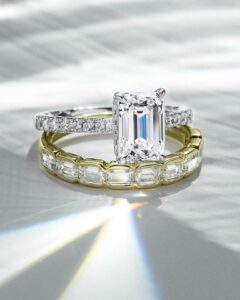Prong
A prong setting – which usually has 4 or 6 prongs – is one of the most popular settings on the market, and is used for all types of faceted stones.
Shared Prong
Similar to the Prong setting, the Shared Prong gets its name from prongs of metal placed between two stones.
Bezel
A versatile choice used for any type of stone, the bezel setting sees the diamond set deep inside of the mounting while the metal is folded over the stone to create a strip that holds the diamond in place.
Half Bezel
This setting utilizes essentially the same approach as the Bezel setting, except a Half Bezel is when the stone’s girdle is not fully covered.
Channel
Another setting that can be used for any type of stone, the channel setting sees the goldsmith creating a channel – as the name would suggest – and then cut seats in it where the diamond will sit. After each diamond is placed in the new channel, the goldsmith secures the stones in place by hammering the upper sides of the channel walls.
Pavé
With pavé settings, several small gemstones – usually diamonds – are set closely together, separated and held in place by small beads of the setting metal. This produces what resembles a continuous string of diamonds or other gems on its surface.
Tension
A relatively new setting, Tension – where ‘springing’ (a metal’s physical characteristic) is used to hold a faceted stone in place – can only be used with gemstones that have a Hardness level of 9 or above. The diamond is first set in small grooves that are cut at the ends of the shank. Following this, between 65-95 lbs. of pressure is exerted on the girdle of the stone being held in place – making the Tension setting one of the most secure to choose from.
Bar
Similar to the Channel setting, the Bar setting sees that diamonds are set between bars, where they are first nested in grooves and then overlapped by metal using a hammering tool. Like the Tension setting, this also requires gemstones to have a Hardness level of 9 or above.

